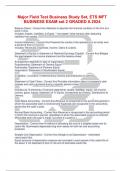Exam (elaborations)
Major Field Test Business Study Set, ETS MFT BUSINESS EXAM set 2 GRADED A 2024
- Course
- Institution
Balance Sheet - Correct Ans-Attempts to describe the financial condition of the firm at a point in time. Includes: Assets, Liabilities, & Equity - "net assets" what remains after deducting liabilities from assets.. Income Statement - Correct Ans-Presents the results of the operations of an enti...
[Show more]



